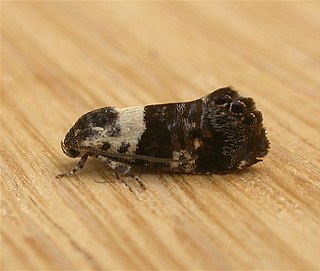Related Research Articles

Eupselia aristonica is a species of moth of the family Depressariidae. It is found in Australia, where it has been recorded from New South Wales, the Australian Capital Territory, Victoria and Tasmania.

Corocosma memorabilis is a species of moth in the family Oecophoridae. It is endemic to New Zealand.
Brenthia gamicopis is a species of moth of the family Choreutidae. It is found in Uganda.
Brenthia spintheristis is a species of moth of the family Choreutidae. It was described by Edward Meyrick in 1910. It is found on the Kei Islands of Indonesia.
Protopterna chalybias is a species of moth of the family Tortricidae. It is found in India (Assam).
Helcystogramma adaequata is a moth in the family Gelechiidae. It was described by Edward Meyrick in 1914. It is found in Guyana.
Charistica porphyraspis is a moth in the family Gelechiidae. It was described by Edward Meyrick in 1909. It is found in Bolivia.
Compsolechia crocodilopa is a moth of the family Gelechiidae. It was described by Edward Meyrick in 1922. It is found in Peru and Pará, Brazil.
Thiotricha obliquata is a moth of the family Gelechiidae. It was described by Shōnen Matsumura in 1931. It is found in Japan and Russia.
Antaeotricha cantharitis is a moth of the family Depressariidae. It is found in French Guiana.
Idiocrates is a monotypic moth genus in the family Depressariidae. Its only species, Idiocrates balanitis, is found in Bolivia. Both the genus and species were first described by Edward Meyrick in 1909.
Comotechna parmifera is a moth in the family Depressariidae. It was described by Edward Meyrick in 1921. It is found in Peru and Pará, Brazil.
Eutorna spintherias is a moth in the family Depressariidae. It was described by Edward Meyrick in 1906. It is found in Australia, where it has been recorded from Victoria and Tasmania.
Psittacastis argentata is a moth in the family Depressariidae. It was described by Edward Meyrick in 1921. It is found in Brazil.
Psittacastis gaulica is a moth in the family Depressariidae. It was described by Edward Meyrick in 1909. It is found in Bolivia.
Psittacastis trierica is a moth in the family Depressariidae. It was described by Edward Meyrick in 1909. It is found in Bolivia.
Antaeotricha melanopis is a moth in the family Depressariidae. It was described by Edward Meyrick in 1909. It is found in Peru.
Chlamydastis epophrysta is a moth in the family Depressariidae. It was described by Edward Meyrick in 1909. It is found in Peru.
Chlamydastis strabonia is a moth in the family Depressariidae. It was described by Edward Meyrick in 1930. It is found in Pará, Brazil.
Imma tetrope is a moth in the family Immidae. It was described by Alexey Diakonoff in 1978. It is found in Nepal.
References
- ↑ Menesta at Markku Savela's Lepidoptera and Some Other Life Forms.
- ↑ Transactions of the Entomological Society of London 1909 (1): 34
| This article on a moth of the subfamily Stenomatinae is a stub. You can help Wikipedia by expanding it. |